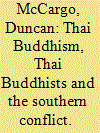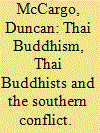|
|
|
Sort Order |
|
|
|
Items / Page
|
|
|
|
|
|
|
| Srl | Item |
| 1 |
ID:
108402


|
|
|
|
|
| Publication |
2011.
|
| Summary/Abstract |
The story of Ya Mo is that of a great Thai heroine honoured with a grand monument (the Suranari memorial) in the centre of Khorat, a city in the north-east of Thailand. The monument is a sacred shrine embedding Ya Mo's guardian spirit which protects the people of the city. She is a grantor of protection, auspiciousness and good luck, and can fulfil wishes, needs and requests. Her spirit can be benevolent as well as ferocious and revengeful. She is a warrior and a guardian, but also a grandmother and a symbol of patriotism, kinship and loving kindness. Ya Mo and her shrine must be perceived in relation to Thai religion and the position of deities, spirits, ghosts and otherworldly beings in Theravada Buddhism. Ya Mo represents a wide range of meanings and functions, but when viewed exclusively as a historical figure, most of these do not surface. In order to understand the Ya Mo phenomenon, the field between religion and magic in Thai Theravada Buddhism must therefore be explored, as well as how people create and uphold distinctions between religion and magic, and how they communicate and negotiate between these two spheres or dimensions. This paper attempts to analyse how non-Buddhist monuments and shrines, in this case a historical memorial to Ya Mo, erected as part of Thai nation-building, represent a vivid part of Thai religious and spiritual life, deeply rooted in a Buddhist worldview.
|
|
|
|
|
|
|
|
|
|
|
|
|
|
|
|
| 2 |
ID:
089368


|
|
|
|
|
| Publication |
2009.
|
| Summary/Abstract |
Thailand's 'southern border provinces' of Pattani, Yala and Narathiwat - along with four districts of neighbouring Songkhla - are the site of fiery political violence characterised by daily killings. The area was historically a Malay sultanate, and was only loosely under Thai suzerainty until the early twentieth century. During the twentieth century there was periodic resistance to Bangkok's attempts to suppress local identity and to incorporate this largely Malay-speaking, Muslim-majority area into a predominantly Buddhist nation-state. This resistance proved most intense during the 1960s and 1970s, when various armed groups (notably PULO [Patani United Liberation Organization] and BRN [Barisan Revolusi Nasional]) waged war on the Thai state, primarily targeting government officials and the security forces. In the early 1980s, the Prem Tinsulanond government brokered a deal with these armed groups and proceeded to co-opt the Malay-Muslim elite. By crafting mutually beneficial governance, security and financial arrangements, the Thai state was able largely to placate local political demands.
|
|
|
|
|
|
|
|
|
|
|
|
|
|
|
|
| 3 |
ID:
096566


|
|
|
|
|
| Publication |
2009.
|
| Summary/Abstract |
Thailand's 'southern border provinces' of Pattani, Yala and Narathiwat - along with four districts of neighbouring Songkhla - are the site of fiery political violence characterised by daily killings. The area was historically a Malay sultanate, and was only loosely under Thai suzerainty until the early twentieth century. During the twentieth century there was periodic resistance to Bangkok's attempts to suppress local identity and to incorporate this largely Malay-speaking, Muslim-majority area into a predominantly Buddhist nation-state. This resistance proved most intense during the 1960s and 1970s, when various armed groups (notably PULO [Patani United Liberation Organization] and BRN [Barisan Revolusi Nasional]) waged war on the Thai state, primarily targeting government officials and the security forces. In the early 1980s, the Prem Tinsulanond government brokered a deal with these armed groups and proceeded to co-opt the Malay-Muslim elite. By crafting mutually beneficial governance, security and financial arrangements, the Thai state was able largely to placate local political demands.
|
|
|
|
|
|
|
|
|
|
|
|
|
|
|
|
|
|
|
|
|